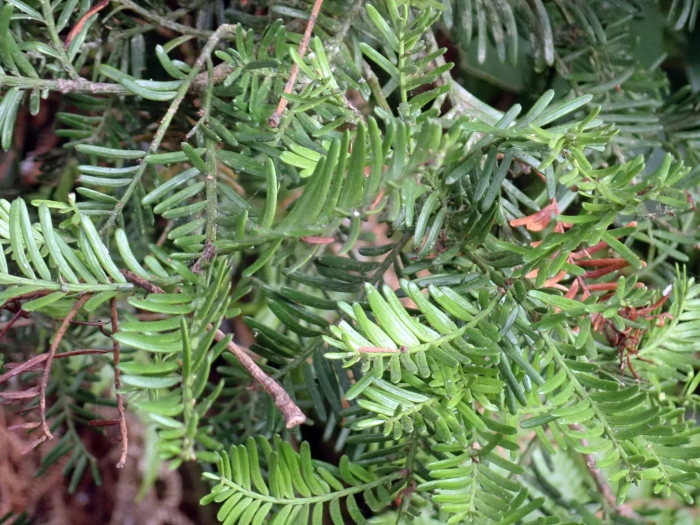Matai
(Prumnopitys taxifolia)
Matai (Prumnopitys taxifolia)
/
/

Peter de Lange
Public Domain
Image By:
Peter de Lange
Recorded By:
Copyright:
Public Domain
Copyright Notice:
Photo by: Peter de Lange | License Type: Public Domain | License URL: http://creativecommons.org/publicdomain/zero/1.0/ | Rights Holder: Peter de Lange | Publisher: iNaturalist | Date Created: 2020-02-22T07:19-08:00 |























































Estimated Native Range
Summary
Prumnopitys taxifolia, commonly known as Matai or Black Pine, is an evergreen coniferous tree native to the podocarp forests of New Zealand, particularly on the North Island and the northeastern parts of the South Island. It can grow up to 40 meters high, with a trunk diameter reaching up to 2 meters. Matai is characterized by its straight trunk and dense, dark green foliage, with leaves that are sharp and stiff. The tree produces small, inconspicuous yellow-green flowers followed by highly modified cones that resemble berries, which are attractive to native birds such as the New Zealand pigeon (kererū).
Matai is valued for its timber, which is hard and durable, making it suitable for flooring and heavy construction. In cultivation, it is used for reforestation projects and as an ornamental specimen in large gardens and parks. It prefers full sun but can tolerate partial shade and requires medium amounts of water. Matai adapts to a range of soil types, provided they have good drainage. While it is not commonly grown outside of New Zealand, it is important to note that it can be slow-growing and may take many years to reach maturity. The tree’s reliance on the kererū for seed dispersal highlights its role in the native ecosystem and the importance of conserving both the tree and bird species.CC BY-SA 4.0
Matai is valued for its timber, which is hard and durable, making it suitable for flooring and heavy construction. In cultivation, it is used for reforestation projects and as an ornamental specimen in large gardens and parks. It prefers full sun but can tolerate partial shade and requires medium amounts of water. Matai adapts to a range of soil types, provided they have good drainage. While it is not commonly grown outside of New Zealand, it is important to note that it can be slow-growing and may take many years to reach maturity. The tree’s reliance on the kererū for seed dispersal highlights its role in the native ecosystem and the importance of conserving both the tree and bird species.CC BY-SA 4.0
Plant Description
- Plant Type: Tree
- Height: 65-80 feet
- Width: 30-50 feet
- Growth Rate: Slow
- Flower Color: N/A
- Flowering Season: Non-Flowering
- Leaf Retention: Evergreen
Growth Requirements
- Sun: Full Sun
- Water: Medium
- Drainage: Slow, Medium, Fast
Common Uses
Bee Garden, Bird Garden, Butterfly Garden, Edible*Disclaimer: Easyscape's listed plant edibility is for informational use. Always verify the safety and proper identification of any plant before consumption., Low Maintenance
Natural Habitat
Native to the podocarp forests of New Zealand, particularly on the North Island and the northeastern parts of the South Island
Other Names
Common Names: Matai, Black-Pine, Ногоплодник Колосистый, 随花罗汉松 (Sui Hua Luo Han Song)
Scientific Names: , Prumnopitys taxifolia, Podocarpus spicatus, Dacrydium mai, Dacrydium taxifolium, Nageia spicata, Prumnopitys spicata, Stachycarpus spicatus,
GBIF Accepted Name: Prumnopitys taxifolia (Banks & Sol. ex D.Don) de Laub.